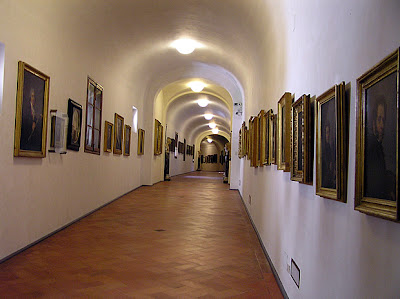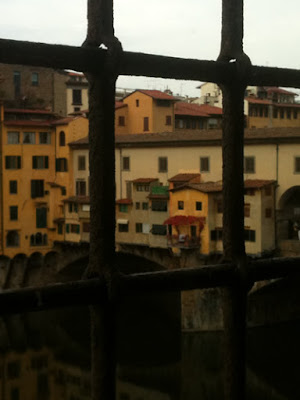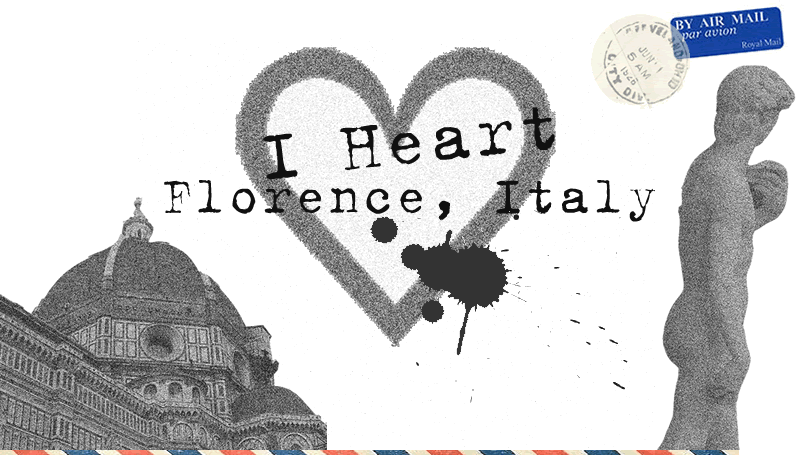| The Corridor that comes out of the Uffizi en runs over the Ponte Vecchio Photo: Copyright discoverflorence (R. v/d Wielen) Hashtag album on Instagram: #discoverflorence |
The Vasari Corridor is part of the 'hidden treasures of Florence' and is open to the public a few months a year. You can only visit this 'secret hallway' by booking quit some time ahead, but it is absolutely worth your while. If you are a real 'treasure' hunter, this is 'The One' you can not miss!
| Uffizi Museum Photo: Copyright discoverflorence (R. v/d Wielen) Hashtag album on Instagram: #discoverflorence |
My visit to the Vasari Corridor
Last week I visited the Vasari Corridor for the second time. It was a grey and rainy day, the perfect weather conditions to discover this mysterious hallway. At 9.00 am the doors to the Corridoio Vasariano (right next to exhibition room n ° 25) opened and we (together with 15/20 people) finally can start our tour.
 |
| Corridoio Vasariano Photocredit |
The story about the Corridor ...
The corridor was commissioned by Cosimo de 'Medici I and built by Vasari in only five months. The Vasari Corridor goes from the Palazzo Vecchio (where the family de'Medici practiced their politics' ) through the Uffizi Gallery (where the administrative offices were) to Palazzo Pitti (where the family de'Medici lived) . The guide explains us (only in Italian) that the Vasarian Corridor was built to avoid life-threatening situations for the de'Medici family. The corridor also acted as an escape route in case of a revolution.
| View from the Corridoio Vasariano Photo: Copyright discoverflorence (R. v/d Wielen) Hashtag album on Instagram: #discoverflorence |
The painting and the bombing ...
Before we walk into the Vasari Corridor, the guide tells us something about the big damaged painting of made by artist Gerrit van Honthorst. This painting, 'L'adorazione dei Pastori', hung opposite a window under which the 1993 Mafia bomb was placed. The glass and the heat damaged the painting so, that little could be saved. Ten years later, the 'L'adorazione dei Pastori ' was restored for about 50% and is now "used "as a symbol of that terrible bomb attack in which five people were killed.
 |
| Photo: Copyright discoverflorence (R. v/d Wielen) Hashtag album on Instagram: #discoverflorence |
The Vasari corridor is nearly 0.62 miles (1 km) long and very narrow (about 3.5 meters wide), you really have to watch out to not accidentally walk against the paintings while you walk and listen to the tourguide. It is an immense feeling that you can come so close to the paintings. On the right side of this part of the Vasari Corridor are hanging the Tuscan painters and on the left site the Italian painters. Most paintings come from the 16th and 17th century.
| Photo: Copyright discoverflorence (R. v/d Wielen) Hashtag album on Instagram: #discoverflorence |
The highlight of your visit to the Corridoio Vasariano will be without doubt the the self portrait collection. Cardinal Leopoldo de 'Medici started this collection for the de'Medici family and gathered the self potraits of well-known artists. At the beginning, the portraits were paid in nature for example with crates of fresh sausage, honey, wine and other delicacies. Gradually the collection of Leopoldo de 'Medici became more and more famous. If you were an artist who counted, then Cardinal Leopold de 'Medici had your portrait! The collection includes a portrait of Rembrandt and a potrait of Chagall.
| Photo: Copyright discoverflorence (R. v/d Wielen) Hashtag album on Instagram: #discoverflorence |
Once arrived on the Ponte Vecchio, you have a great view from the large windows. These windows were made on occasion of the visit of Hitler, guest of Mussolini. The story goes that Hitler was so impressed by the bridge and the view, that he saved the Ponte Vecchio during World War II.
| Photo: Copyright discoverflorence (R. v/d Wielen) Hashtag album on Instagram: #discoverflorence |
| Palazzo Pitti Photo: Copyright discoverflorence (R. v/d Wielen) Hashtag album on Instagram: #discoverflorence |
Wondering and gazing at the most beautiful portraits and before we know it, the Vasari Corridor ends and we're standing in the Boboli Garden..... it's still raining and the sun i is nowhere to be seen, time for a warm cappuccino...
------------------------------------------------
Opening days Vasari Corridor :
5th of october untill the 16th of december 2011
Openinghours:
(The tour is about 1 1/2 and is only given in Italian language)
Wed and fri at 2.00pm and 4.30pm
thu at 9.00am en 11.30am
Tickets:
€ 15
Reservations:
Tel: 0039 (0)55-294883 (Firenze Musei)
-----------------------------------------------------------
Note 1°: Every day a nice photo of Florence ? Follow 'ontdekflorence' on Instagram
Note 1°: Every day a nice photo of Florence ? Follow 'ontdekflorence' on Instagram
checkout hashtag album: #discoverflorence on Inkstagram
Note 2°: You can't take pictures of the paintings and sculptures in the Vasari Corridor
Note 2°: You can't take pictures of the paintings and sculptures in the Vasari Corridor

















